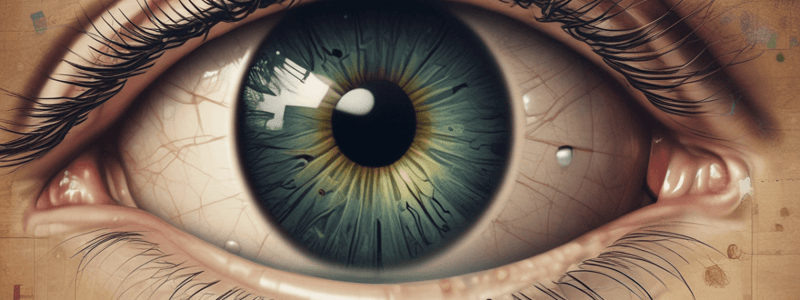Podcast
Questions and Answers
What are the assessments of the eye
What are the assessments of the eye
- Hypotropia
- Exotropia
- Perrla
- sk about family history – glaucoma, dm, blindness and cataracts Visual acuity tests SNELLEN – alphabetical letters with largest letters On top progressing to smallest E-chart – for people who have reading problems. Indicate direction of the letter E Normal vision – 20/20 patient can read at 20 feet what the normal eye can read at same distance (correct)
At what visual acuity is low vision considered to occur?
At what visual acuity is low vision considered to occur?
- 20/100
- 20/200
- 20/20
- 20/70 (correct)
What is the purpose of the Snellen chart?
What is the purpose of the Snellen chart?
- To assess muscle balance and movement
- To assess visual acuity using alphabetical letters (correct)
- To assess peripheral vision
- To assess color vision
What does the abbreviation 'OU' stand for in documenting eye exams?
What does the abbreviation 'OU' stand for in documenting eye exams?
What is the term for the ability to see objects on the sides while eyes are focused forward?
What is the term for the ability to see objects on the sides while eyes are focused forward?
Flashcards are hidden until you start studying
Study Notes
Vitreous Humor and Liquids
- Vitreous humor is thick, while other liquids in the eye are thin
Color Vision and Rods
- Rods help individuals see shades of grey
- Ask about family history of glaucoma, diabetes, blindness, and cataracts for assessment of color vision
Visual Acuity Tests
- Snellen chart: uses alphabetical letters with largest letters on top, progressing to smallest
- E-chart: used for individuals with reading problems, indicates direction of the letter E
- Normal vision: 20/20, patient can read at 20 feet what the normal eye can read at the same distance
Assessment of Eye and Vision
- Low vision: occurs at 20/70
- Legal blindness: occurs at 20/200
- Documentation: OD - right eye, OS - left eye, OU - both eyes
- Must include "with" or "without" correction
Peripheral Vision
- Ability to see objects on the sides when eyes are forward
- Assessment of peripheral vision
Muscle Balance and Movement
- Test to follow examiner's fingers with eyes forward in all 6 cardinal fields of gaze
- Checks for muscle strength and balance of eye, and functioning of cranial nerves 3, 4, and 6
- Six Cardinal Fields of Gaze: assessment of muscle balance and movement
Important Terms
- Esotropia: deviation of the eye towards the nose
- Exotropia: deviation of the eye away from the nose
- Hypotropia: deviation of eye downward
- Hypertropia: deviation of the eye upward
- Perrla: pupils equal, round, reactive to light and accommodation
Studying That Suits You
Use AI to generate personalized quizzes and flashcards to suit your learning preferences.




